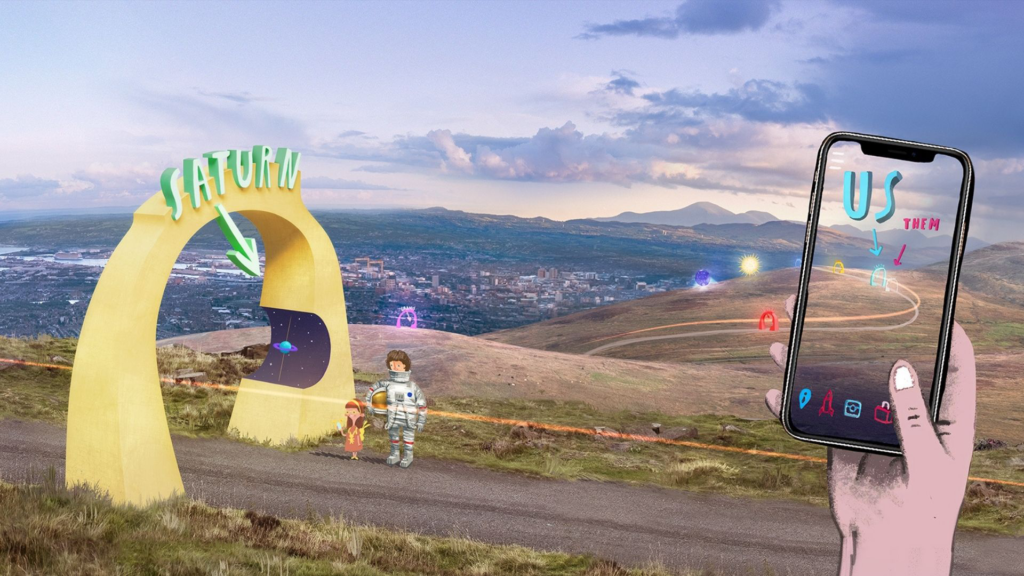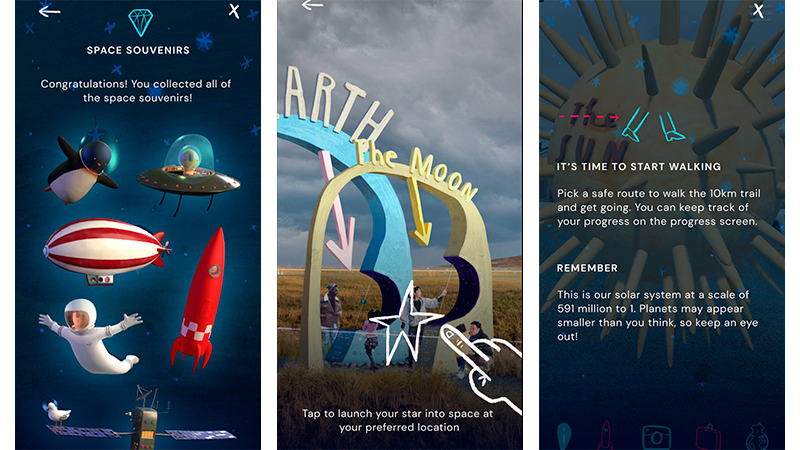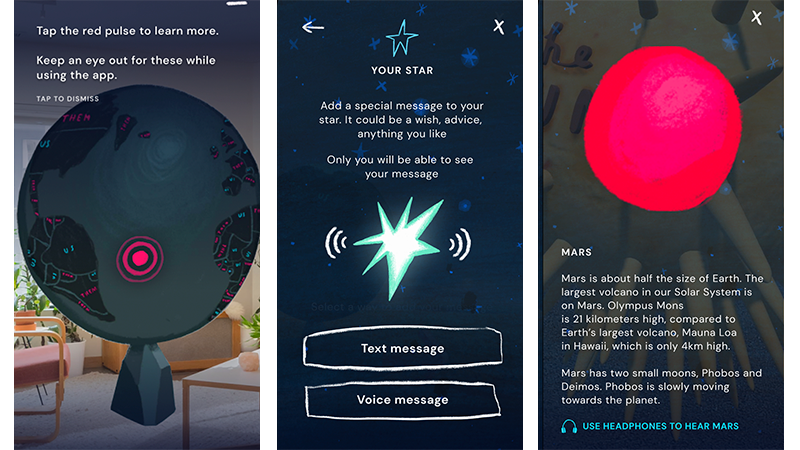Our Company
Hamilton Robson is a technology company, specialising in audio visual and software development.
We create unforgettable experiences and solutions for ultramodern spaces.
Useful Links
Menu
Presented by Nerve Centre, Our Place in Space, or OPIS is described as “an astonishing journey through our solar system, recreated as a 10km-long sculpture trail exploring what it means to live life on Earth” designed by artist and children’s author, Oliver Jeffers.
In collaboration with UNBOXED, Our Place in Space was delivered by many great teams with the goal of creating an educational experience accessible to just about anyone.
Our Place In Space is made up of two main parts:
Hamilton Robson and Big Motive delivered the AR app for explorers to learn more about the solar system as they walked the equivalent distance. The app offers many different features to engage explorers, such as in-depth planet information, man-made and extra-terrestrial objects in space and souvenirs that you can find and unlock on your journey.
The teams worked with Oliver Jeffers to deliver his unique aesthetic and storytelling experience for visitors.
We worked with Big Motive to deliver OPIS as they saw it. Hamilton Robson’s expertise is mobile app development and immersive technologies like AR put us in a prime position to deliver this epic project.
OPIS was developed with React Native and Unity. A technology stack that we have become familiar with through delivering past projects. While these two technologies can be awkward to bring together, when done correctly it can be effective in creating an experience that takes advantage of both.
The app required a diverse set of features such as AR, GPS location tracking and step counting. While AR was used right across the app as it was the primary method of delivering content, GPS location tracking, and step counting were used separately for separate experiences.

We added a digital layer on top of the physical trail that travelled across the UK. Each sculpture unique in demonstrating the true scale of the universe. The app allowed players to explore the solar system in more detail. Information cards with rich content and information are displayed when each sculpture is reached and could be accessed again by AR interactions around the physical sculpture.
The virtual trail was created to be able to take the solar system anywhere with you in the world. This required the 10km trail to scale to anywhere. The app tracks the player’s distance travelled and throughout travelling they can discover the same planets they would see on the physical trail. This mode takes full advantage of AR and delivers amazing looking assets for Oliver Jeffers’ style.
To cater for those who are unable to travel the distance of either trail, they can visit the solar system from their homes. All the content that you would discover along the trail is made accessible in this mode, delivering an inclusive experience – you don’t have to be on the trail to enjoy and learn, which is great.
Space Stuff is a collection of extra-terrestrial objects throughout our solar system that you can discover and find out more about as you travel. To further gamify the exploration, unique stylised characters or ‘souvenirs’ were created that you can discover along the way.

Working on this project was fun, creative, and collaborative. For us, it was a chance to flex our augmented reality muscles and learn lots of new things along the way. Here, I’ve outlined some of the key technical takeaways AR developers might want to consider when planning out large scale projects of a similar nature.
The reason we choose a specific tool to build experiences with is because that tool is equipped to deliver features for that experience. React Native is often chosen as a native front-end solution to speed up the delivery of two separate mobile platforms. Unity does this also but what Unity does not do well at least without a lot of time spent is fluid UI.
OPIS was built primarily with Unity to deliver the rich AR experiences for the players. React Native gave us access to long a list of useful libraries and tools that we built on top of the Unity experience.
Some may not know that Unity can be built as a library to be integrated with other technologies to create seamless experiences. A great example of this is IKEA’s app which takes advantage of Unity as a Library. See this video for a deeper dive.
The AR was developed using Unity; this gives us access to specific tools. AR Foundation was our main tool of choice as it is for a lot of AR experiences developed in the same engine. AR Foundation combines the offerings of both ARKit and ARCore, offered by Apple and Google respectively. What ARKit provides but ARKit doesn’t is access to the combination of GPS coordinates and 3D world space in your AR experience. This means you can build AR that is attached to real world locations.
AR Foundation wraps both ARKit and ARCore to make it easier to build cross platform AR experiences. For that reason, we chose AR Foundation; while it couldn’t support the combination of GPS with AR out of the box, the AR tools alone are valuable. This left us having to build in our own GPS functionality and combine that data with the AR capabilities of the app.
We took advantage of the libraries available in React Native’s ecosystem and delivered the GPS capability through it. We then allowed Unity to receive information from the GPS systems. Unity effectively was a useful tool to deliver AR content where and when we needed it.
While this approach worked well, and we would consider this architecture again. There is a new alternative that offers all the above and more in one solution. Niantic Lightship is a valid alternative if you are looking to build an experience like this.
Our Place in Space is unique in that you can experience the solar system to scale anywhere in the world, or alongside physical sculptures. The team wanted to create an experience that was fun to explore with others and you could take home with you later to explore and learn.
AR gives you the unique opportunity to use our world to build content on top of. This can give guests unique perspectives. While the guest explores the trail whether remotely or with the physical sculptures, we reward them with items that are only discoverable by the more distance you cover. The “Space Souvenirs” are unique to Our Place in Space, created by Oliver Jeffers and can be found through the AR trail.

Our Place in Space is a longer than average AR experience. We are pushing the limits of an AR experience when it comes to time of engagement. 10km takes roughly three hours to walk; to put that in relative perspective, running a reliable AR experience on a mobile device for 3 hours is very difficult to do.
The typical use of the app looks like a guest opening the app briefly at every stop point for roughly five minutes before continuing. This pattern coupled with the amount of content means we managed to find a sweet spot between use and battery life.
While we advise guests to still bring battery packs, we have found through testing that their phone’s will typically make the full length on a full charge.
To achieve this we had to make considerations elsewhere. The GPS works throughout the whole experience in the background. At a regular interval it pings to understand where it is. If it falls within a boundary of a specified location content is activated. The optimal ping interval was important to find the balance with, as to not drain the battery either.
To generate an accurate representation of the journey a guest may take, the ping rate for the GPS was required to be frequent. This led to battery level concerns. The more often the app pinged location and completed calculation on those coordinates, the quicker the battery would drain.
Across the whole trail we found a ping rate that was acceptable without sacrificing a lot of detail, but we knew further optimisations could be made.
We realised that we could take advantage of the layout of the solar system. Most of the usage happened early in the trail, up to Mars. If you look at the solar system, a lot of planets are grouped closer to the Sun at least up until Mars. The app makes sure that the guest has reached Mars before increasing the gap between pings. While the start of the trail was recorded in finer detail, the last section wasn’t. It was the max time interval we could settle on without truly affecting the experience.
Download Our Place In Space Now!
The Our Place In Space augmented reality app is now available on both the App Store and Play Store!
Thank You:
Big Motive have written an excellent blog on the design considerations – check it out here.
The team: Big Motive, Taunt, Hamilton Robson, Yellow Design, Nerve Centre.
Jake Young, Software Engineer
About UNBOXED
UNBOXED is a celebration of creativity taking place across the UK in 2022, designed to reach millions and bring people together. It features free large-scale events, installations, and globally accessible digital experiences in the UK’s most ambitious showcase of creative collaboration. Produced by some of the brightest minds in science, technology, engineering, arts and maths, UNBOXED features ten major multi-site and digital creative projects that share new ideas and possibilities for the future.
Want to find out how the subject of this blog could help your business?
Our blended team of experts go over and above with our services to our customers, no matter what the challenge. Get in touch to find out how we can work together.
Hamilton Robson is a technology company, specialising in audio visual and software development.
We create unforgettable experiences and solutions for ultramodern spaces.
| Cookie | Duration | Description |
|---|---|---|
| cookielawinfo-checkbox-analytics | 11 months | This cookie is set by GDPR Cookie Consent plugin. The cookie is used to store the user consent for the cookies in the category "Analytics". |
| cookielawinfo-checkbox-functional | 11 months | The cookie is set by GDPR cookie consent to record the user consent for the cookies in the category "Functional". |
| cookielawinfo-checkbox-necessary | 11 months | This cookie is set by GDPR Cookie Consent plugin. The cookies is used to store the user consent for the cookies in the category "Necessary". |
| cookielawinfo-checkbox-others | 11 months | This cookie is set by GDPR Cookie Consent plugin. The cookie is used to store the user consent for the cookies in the category "Other. |
| cookielawinfo-checkbox-performance | 11 months | This cookie is set by GDPR Cookie Consent plugin. The cookie is used to store the user consent for the cookies in the category "Performance". |
| viewed_cookie_policy | 11 months | The cookie is set by the GDPR Cookie Consent plugin and is used to store whether or not user has consented to the use of cookies. It does not store any personal data. |